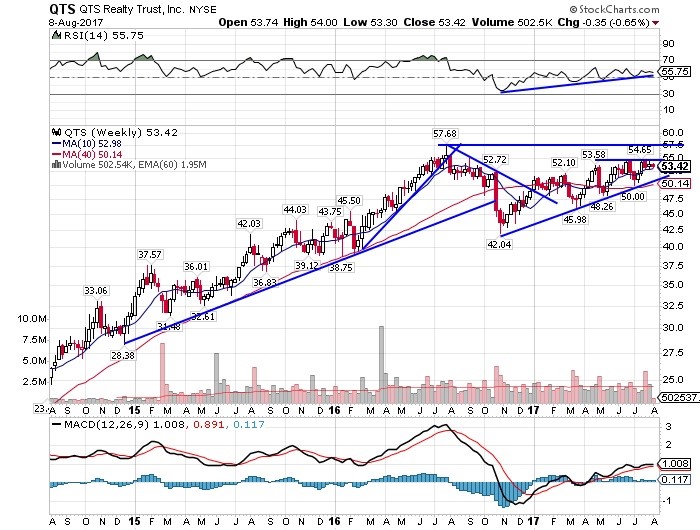As demand for data grows, so does the need for more hardware and storage space. That, in turn, drives the stock price of these data center REITs, which safely store data and supply uninterrupted power, cool air, and physical security for their tenants' servers, notes Dr. Carla Pasternak, editor of Dow Theory Letters.
Get Top Pros' Top Picks, MoneyShow’s free investing newsletter »
QTS Realty Trust (QTS) sets itself apart from other data centers by focusing on security and Department of Defense compliance.
This strategy attracts security sensitive industries including government agencies and contractors. The data center also offers a one-stop shop with a complete suite of services for both wholesale and retail business clients, plus in-house cloud and management services.
While keeping confidential the names of its clients, the company has revealed that it does business with most leading cloud service providers and some of the largest banks as well as well-known tech firms, industrial companies and retailers.
Headquartered in Overland Park, Kansas, QTS owns, operates or manages 25 data centers across the U.S. Although QTS has the smallest market cap among publicly traded data centers, its 969,000 square foot center in Atlanta, Georgia is one of the world's largest and is occupied by 227 customers.
Earnings per share surged from $0.09 in 2013 to $0.51 in 2014, mainly driven by acquisitions. Since then, earnings have been relatively stable, at $0.44 in 2017, slightly below 2016's $0.46.
In 2018, however, earnings are forecast to jump 39% to $0.61 per share, as its $42 million annual backlog of leases that have been signed but not billed kicks in.
Dividends have grown an average of 10% annually over the last three years, to $1.56 per share in 2017. The shares yield almost 3% ($1.56/$53.42). Most of the distribution is taxable as ordinary income at your marginal income tax rate, so the shares are best held in a tax-deferred IRA-type of account.
The shares more than doubled in the two and a half years following their debut in October 2013 at $21 per share. As can be seen in the chart below, however, after peaking at $57.68 in August 2016, the shares then breached an accelerated uptrend, due in part to the one-time lease cancellation of a government contractor.
The shares continued to sell off in the second half of 2016, breaking a long-term uptrend in late October. Since bottoming at $42.04 last November, the shares have marched higher and they are now trading above their rising 10-week as well as 40-week moving averages.
They have bullishly formed a small ascending triangle with minor resistance just below $55 and major resistance below $58. There is indicator confirmation, with a rising RSI just above the key 50-level and a rising MACD giving a fresh buy signal.
The technicals are positive, with rising price trend, RSI, and MACD all signaling a move forward. Forecast earnings growth next year supports the attractive price chart. Our recommendation is to buy based on the firm slow and steady growth strategy.






















